change wheel TOYOTA BZ4X 2022 Owners Manual (in English)
[x] Cancel search | Manufacturer: TOYOTA, Model Year: 2022, Model line: BZ4X, Model: TOYOTA BZ4X 2022Pages: 674, PDF Size: 120.02 MB
Page 46 of 674
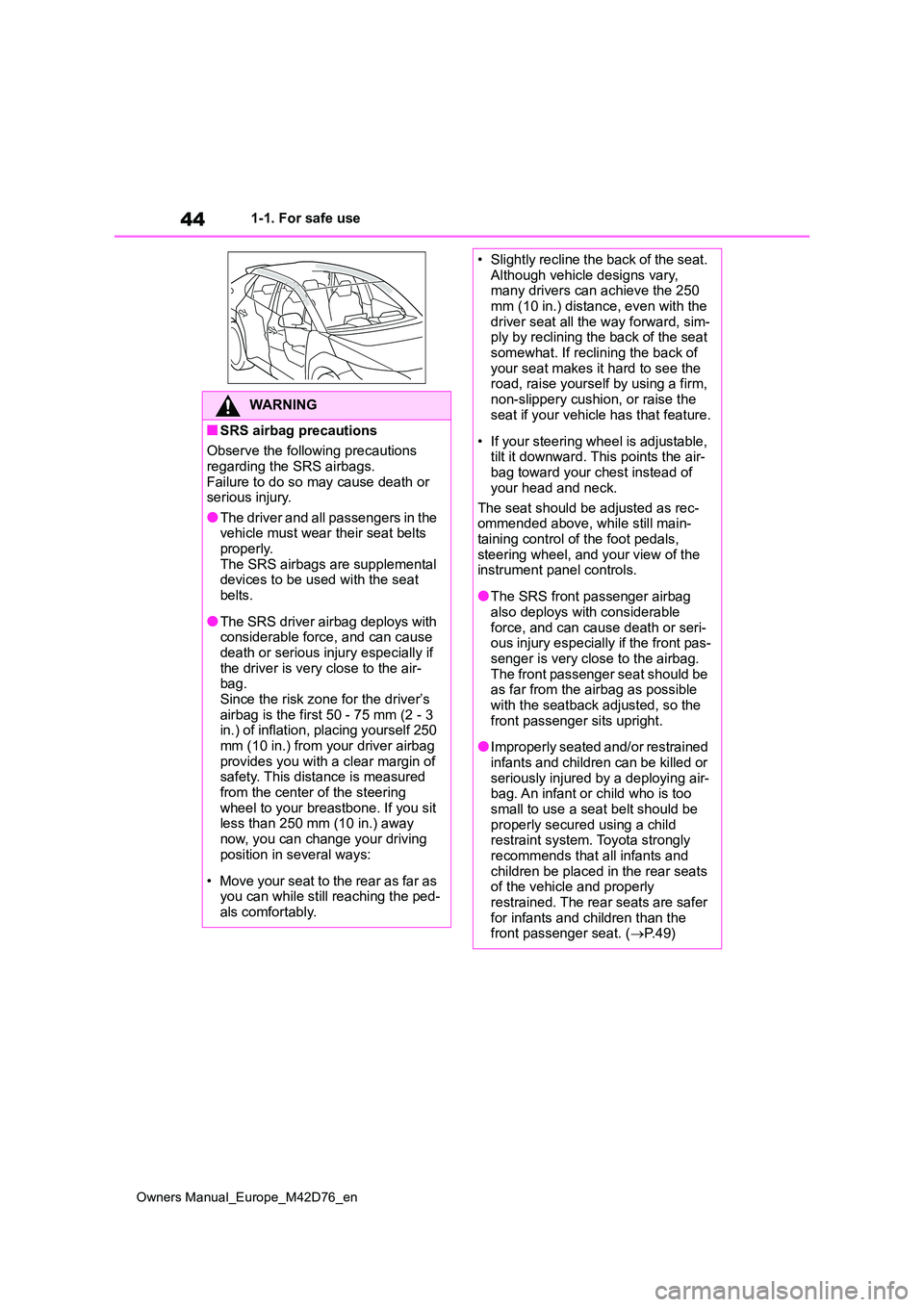
44
Owners Manual_Europe_M42D76_en
1-1. For safe use
WARNING
■SRS airbag precautions
Observe the following precautions
regarding the SRS airbags. Failure to do so may cause death or serious injury.
●The driver and all passengers in the vehicle must wear their seat belts properly.
The SRS airbags are supplemental devices to be used with the seat belts.
●The SRS driver airbag deploys with considerable force, and can cause
death or serious injury especially if the driver is very close to the air-bag.
Since the risk zone for the driver’s airbag is the first 50 - 75 mm (2 - 3 in.) of inflation, placing yourself 250
mm (10 in.) from your driver airbag provides you with a clear margin of safety. This distance is measured
from the center of the steering wheel to your breastbone. If you sit less than 250 mm (10 in.) away
now, you can change your driving position in several ways:
• Move your seat to the rear as far as you can while still reaching the ped-als comfortably.
• Slightly recline the back of the seat. Although vehicle designs vary, many drivers can achieve the 250
mm (10 in.) distance, even with the driver seat all the way forward, sim-ply by reclining the back of the seat
somewhat. If reclining the back of your seat makes it hard to see the road, raise yourself by using a firm,
non-slippery cushion, or raise the seat if your vehicle has that feature.
• If your steering wheel is adjustable, tilt it downward. This points the air-bag toward your chest instead of
your head and neck.
The seat should be adjusted as rec- ommended above, while still main-
taining control of the foot pedals, steering wheel, and your view of the instrument panel controls.
●The SRS front passenger airbag also deploys with considerable
force, and can cause death or seri- ous injury especially if the front pas-senger is very close to the airbag.
The front passenger seat should be as far from the airbag as possible with the seatback adjusted, so the
front passenger sits upright.
●Improperly seated and/or restrained
infants and children can be killed or seriously injured by a deploying air-bag. An infant or child who is too
small to use a seat belt should be properly secured using a child restraint system. Toyota strongly
recommends that all infants and children be placed in the rear seats of the vehicle and properly
restrained. The rear seats are safer for infants and children than the front passenger seat. ( P. 4 9 )
Page 180 of 674
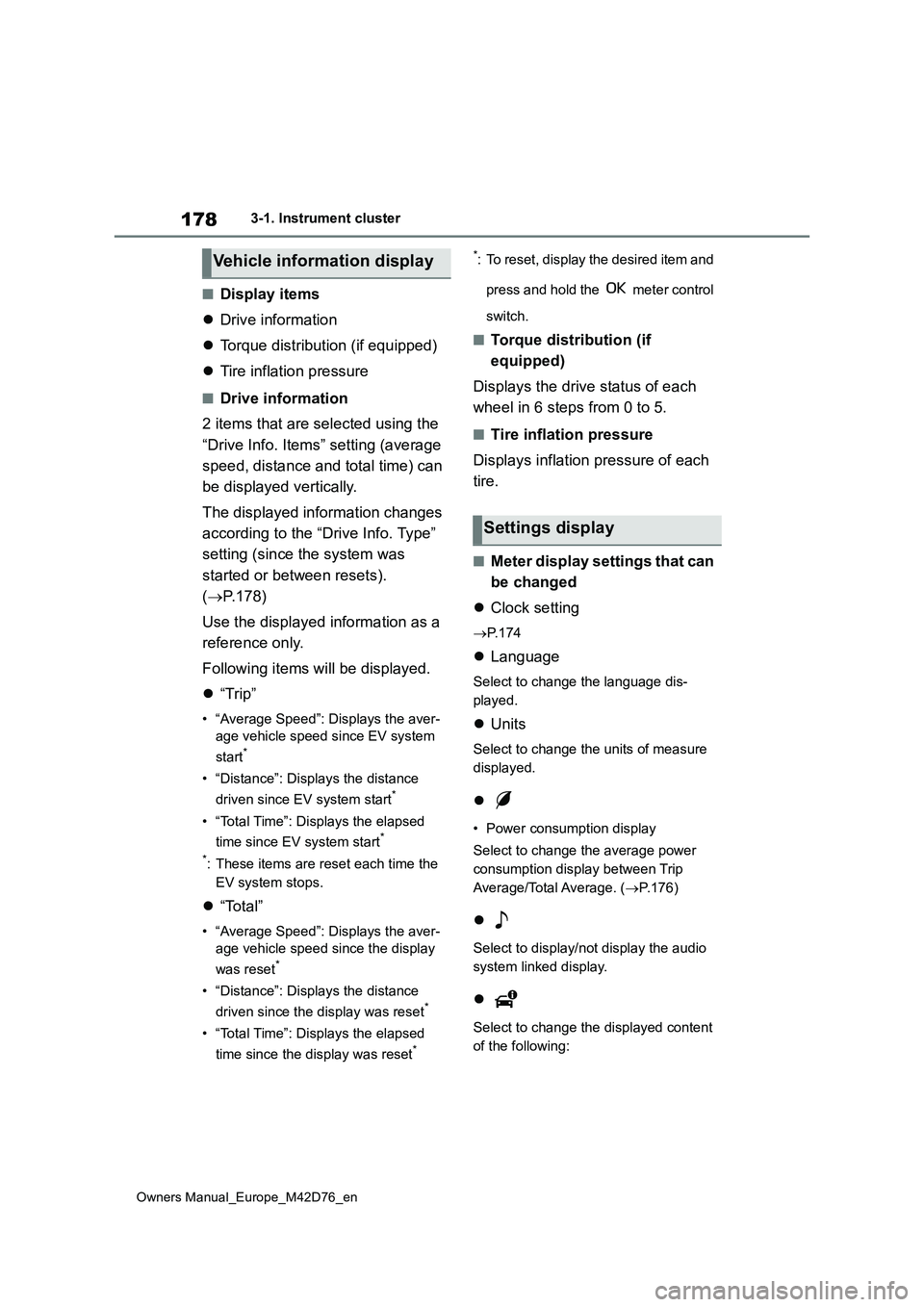
178
Owners Manual_Europe_M42D76_en
3-1. Instrument cluster
■Display items
Drive information
Torque distribution (if equipped)
Tire inflation pressure
■Drive information
2 items that are selected using the
“Drive Info. Items” setting (average
speed, distance and total time) can
be displayed vertically.
The displayed information changes
according to the “Drive Info. Type”
setting (since the system was
started or between resets).
( P.178)
Use the displayed information as a
reference only.
Following items will be displayed.
“Trip”
• “Average Speed”: Displays the aver-
age vehicle speed since EV system
start*
• “Distance”: Displays the distance
driven since EV system start*
• “Total Time”: Displays the elapsed
time since EV system start*
*: These items are reset each time the
EV system stops.
“Total”
• “Average Speed”: Displays the aver-
age vehicle speed since the display
was reset*
• “Distance”: Displays the distance
driven since the display was reset*
• “Total Time”: Displays the elapsed
time since the display was reset*
*: To reset, display the desired item and
press and hold the meter control
switch.
■Torque distribution (if
equipped)
Displays the drive status of each
wheel in 6 steps from 0 to 5.
■Tire inflation pressure
Displays inflation pressure of each
tire.
■Meter display settings that can
be changed
Clock setting
P. 1 7 4
Language
Select to change the language dis-
played.
Units
Select to change the units of measure
displayed.
• Power consumption display
Select to change the average power
consumption display between Trip
Average/Total Average. ( P.176)
Select to display/not display the audio
system linked display.
Select to change the displayed content
of the following:
Vehicle information display
Settings display
Page 220 of 674
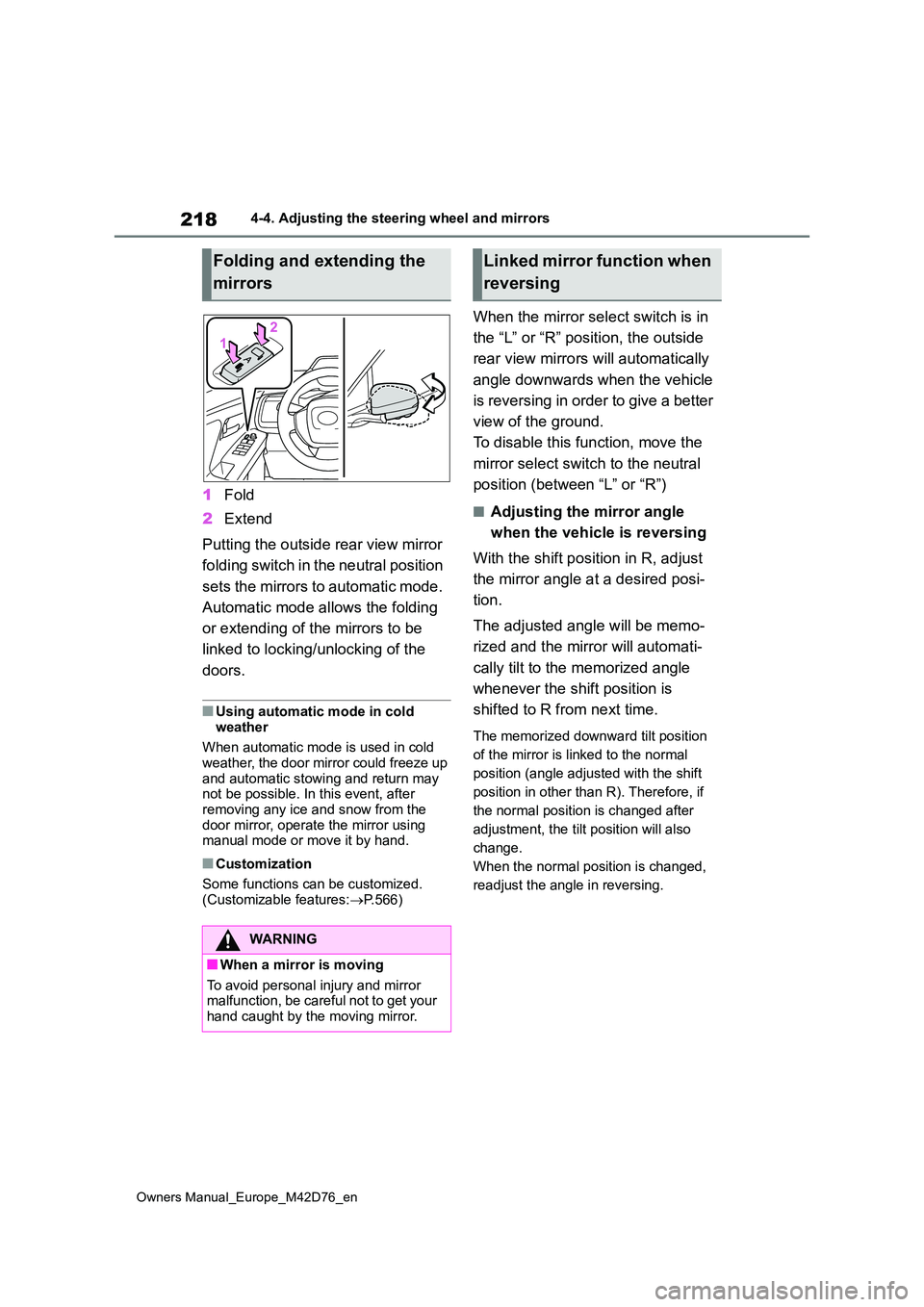
218
Owners Manual_Europe_M42D76_en
4-4. Adjusting the steering wheel and mirrors
1Fold
2 Extend
Putting the outside rear view mirror
folding switch in the neutral position
sets the mirrors to automatic mode.
Automatic mode allows the folding
or extending of the mirrors to be
linked to locking/unlocking of the
doors.
■Using automatic mode in cold
weather
When automatic mode is used in cold weather, the door mirror could freeze up
and automatic stowing and return may not be possible. In this event, after removing any ice and snow from the
door mirror, operate the mirror using manual mode or move it by hand.
■Customization
Some functions can be customized.
(Customizable features: P.566)
When the mirror select switch is in
the “L” or “R” position, the outside
rear view mirrors will automatically
angle downwards when the vehicle
is reversing in order to give a better
view of the ground.
To disable this function, move the
mirror select switch to the neutral
position (between “L” or “R”)
■Adjusting the mirror angle
when the vehicle is reversing
With the shift position in R, adjust
the mirror angle at a desired posi-
tion.
The adjusted angle will be memo-
rized and the mirror will automati-
cally tilt to the memorized angle
whenever the shift position is
shifted to R from next time.
The memorized downward tilt position
of the mirror is linked to the normal
position (angle adjusted with the shift
position in other than R). Therefore, if
the normal position is changed after
adjustment, the tilt position will also
change.
When the normal position is changed,
readjust the angle in reversing.
Folding and extending the
mirrors
WARNING
■When a mirror is moving
To avoid personal injury and mirror malfunction, be careful not to get your hand caught by the moving mirror.
Linked mirror function when
reversing
Page 236 of 674
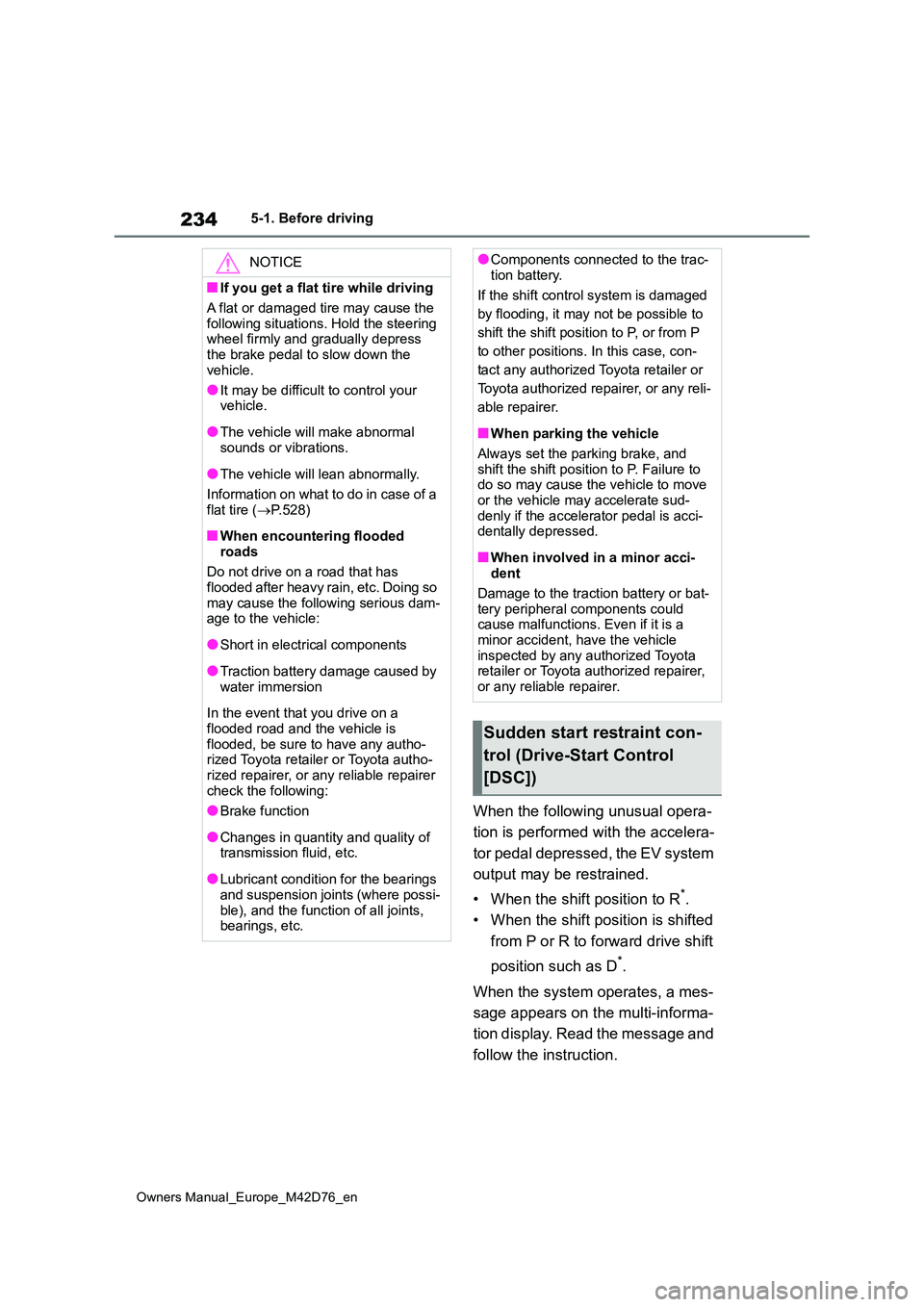
234
Owners Manual_Europe_M42D76_en
5-1. Before driving
When the following unusual opera-
tion is performed with the accelera-
tor pedal depressed, the EV system
output may be restrained.
• When the shift position to R*.
• When the shift position is shifted
from P or R to forward drive shift
position such as D*.
When the system operates, a mes-
sage appears on the multi-informa-
tion display. Read the message and
follow the instruction.
NOTICE
■If you get a flat tire while driving
A flat or damaged tire may cause the
following situations. Hold the steering wheel firmly and gradually depress the brake pedal to slow down the
vehicle.
●It may be difficult to control your vehicle.
●The vehicle will make abnormal sounds or vibrations.
●The vehicle will lean abnormally.
Information on what to do in case of a
flat tire ( P.528)
■When encountering flooded
roads
Do not drive on a road that has flooded after heavy rain, etc. Doing so
may cause the following serious dam- age to the vehicle:
●Short in electrical components
●Traction battery damage caused by
water immersion
In the event that you drive on a
flooded road and the vehicle is flooded, be sure to have any autho-rized Toyota retailer or Toyota autho-
rized repairer, or any reliable repairer check the following:
●Brake function
●Changes in quantity and quality of transmission fluid, etc.
●Lubricant condition for the bearings and suspension joints (where possi-
ble), and the function of all joints, bearings, etc.
●Components connected to the trac-tion battery.
If the shift control system is damaged
by flooding, it may not be possible to
shift the shift position to P, or from P
to other positions. In this case, con-
tact any authorized Toyota retailer or
Toyota authorized repairer, or any reli-
able repairer.
■When parking the vehicle
Always set the parking brake, and
shift the shift position to P. Failure to do so may cause the vehicle to move or the vehicle may accelerate sud-
denly if the accelerator pedal is acci- dentally depressed.
■When involved in a minor acci-dent
Damage to the traction battery or bat-
tery peripheral components could cause malfunctions. Even if it is a minor accident, have the vehicle
inspected by any authorized Toyota retailer or Toyota authorized repairer, or any reliable repairer.
Sudden start restraint con-
trol (Drive-Start Control
[DSC])
Page 243 of 674

241
5
Owners Manual_Europe_M42D76_en
5-1. Before driving
Driving
is especially true when driving on
wet or slippery road surfaces.
■Sudden acceleration/steering
input/cornering
Executing sharp turns when towing
may result in the trailer colliding
with your vehicle. Decelerate well in
advance when approaching turns
and take them slowly and carefully
to avoid sudden braking.
■Important points regarding
turning
The wheels of the trailer will travel
closer to the inside of the curve
than the wheels of the vehicle. To
make allowance for this, take the
turns wider than you would nor-
mally do.
■Important points regarding
stability
Vehicle movement resulting from
uneven road surfaces and strong
crosswinds will affect handling. The
vehicle may also be rocked by
passing buses or large trucks. Fre-
quently check behind when moving
alongside such vehicles. As soon
as such vehicle movement occurs,
immediately start to decelerate
smoothly by slowly applying the
brakes. Always steer the vehicle
straight ahead while braking.
■Passing other vehicles
Consider the total combined length
of your vehicle and trailer and
ensure that the vehicle-to-vehicle
distance is sufficient before execut-
ing lane changes.
■If the EV system overheats
Towing a loaded trailer up a long,
steep incline in temperatures
exceeding 30°C (85°F) may result
in the EV system overheating. If the
EV system coolant temperature
gauge indicates that the EV system
is overheating, turn the air condi-
tioning off immediately, leave the
road and stop the vehicle in a safe
place. ( P.549)
■When parking the vehicle
Always place wheel chocks under
the wheels of both the vehicle and
trailer. Firmly set the parking brake
and shift the shift position to P.
WARNING
F o l l o w a l l t h e i n s t r u c t i o n s d e s c r i b e d i n this section. Failure to do so could cause an accident resulting in death
or serious injury.
■Trailer towing precautions
When towing, make sure that none of the weight limits are exceeded. ( P.554)
■Vehicle speed in towing
Observe the legal maximum speeds
for trailer towing.
■Before descending hills or long
declines
Reduce speed and downshift. How- ever, never downshift suddenly while
descending steep or long downhill grades.
Page 246 of 674
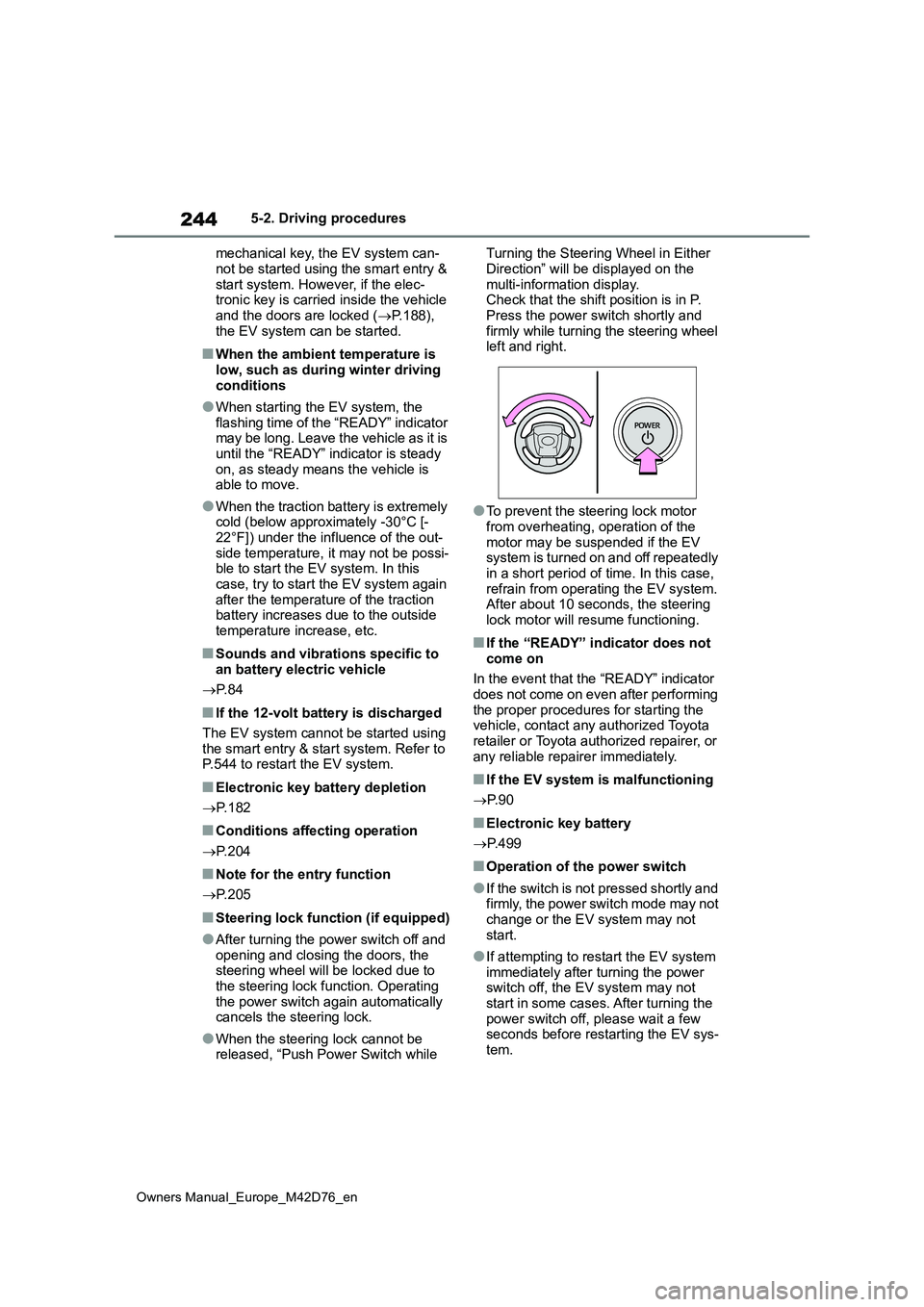
244
Owners Manual_Europe_M42D76_en
5-2. Driving procedures
mechanical key, the EV system can-
not be started using the smart entry & start system. However, if the elec-tronic key is carried inside the vehicle
and the doors are locked ( P.188), the EV system can be started.
■When the ambient temperature is low, such as during winter driving
conditions
●When starting the EV system, the
flashing time of the “READY” indicator may be long. Leave the vehicle as it is until the “READY” indicator is steady
on, as steady means the vehicle is able to move.
●When the traction battery is extremely cold (below approximately -30°C [-22°F]) under the influence of the out-
side temperature, it may not be possi- ble to start the EV system. In this case, try to start the EV system again
after the temperature of the traction battery increases due to the outside temperature increase, etc.
■Sounds and vibrations specific to
an battery electric vehicle
P. 8 4
■If the 12-volt battery is discharged
The EV system cannot be started using
the smart entry & start system. Refer to P.544 to restart the EV system.
■Electronic key battery depletion
P. 1 8 2
■Conditions affecting operation
P. 2 0 4
■Note for the entry function
P. 2 0 5
■Steering lock function (if equipped)
●After turning the power switch off and opening and closing the doors, the steering wheel will be locked due to
the steering lock function. Operating the power switch again automatically cancels the steering lock.
●When the steering lock cannot be released, “Push Power Switch while
Turning the Steering Wheel in Either
Direction” will be displayed on the multi-information display.Check that the shift position is in P.
Press the power switch shortly and firmly while turning the steering wheel left and right.
●To prevent the steering lock motor from overheating, operation of the
motor may be suspended if the EV system is turned on and off repeatedly in a short period of time. In this case,
refrain from operating the EV system. After about 10 seconds, the steering lock motor will resume functioning.
■If the “READY” indicator does not
come on
In the event that the “READY” indicator does not come on even after performing
the proper procedures for starting the vehicle, contact any authorized Toyota retailer or Toyota authorized repairer, or
any reliable repairer immediately.
■If the EV system is malfunctioning
P. 9 0
■Electronic key battery
P. 4 9 9
■Operation of the power switch
●If the switch is not pressed shortly and firmly, the power switch mode may not
change or the EV system may not start.
●If attempting to restart the EV system immediately after turning the power switch off, the EV system may not
start in some cases. After turning the power switch off, please wait a few seconds before restarting the EV sys-
tem.
Page 266 of 674

264
Owners Manual_Europe_M42D76_en
5-3. Operating the lights and wipers
• When a vehicle ahead is a two-
wheeled vehicle • The condition of the road (gradient, curve, condition of the road surface,
etc.) • The number of passengers and amount of luggage
●The light distribution control of the headlights may not match the driver’s
expectations
●Bicycles and other small vehicles may
not be detected.
●In the following situations, the system
may not be able to correctly detect the brightness of the surroundings. This may cause the low beams to remain
on or the high beams to flash or daz- zle pedestrians or vehicles ahead. In such a case, it is necessary to manu-
ally change between the high beams and low beams.• When there are lights similar to head-
lights or tail lights in the surrounding area• When headlights or tail lights of vehi-
cles ahead are turned off, dirty, chang- ing color, or not aimed properly• When the headlights are repeatedly
changing between the high beams and low beams.• When use of the high beams is inap-
propriate or when the high beams may be flashing or dazzling pedestri-ans or other drivers.
• When the vehicle is used in an area in which vehicles travel on the opposite side of the road of the country for
which the vehicle was designed, for example using a vehicle designed for right-hand traffic in a left-hand traffic
area, or vice versa • When it is necessary to disable the system: P. 2 7 5
• Situations in which the sensors may not operate properly: P. 2 7 9
■Customization
The settings of some functions can be
changed. ( P.567)
■Changing to the high beams
Push the lever forward.
The AHS indicator will turn off and the
high beam indicator will turn on.
Pull the lever to its original position to
enable the Adaptive High-beam Sys-
tem again.
■Changing to the low beams
Press the Adaptive High-beam Sys-
tem switch.
The AHS indicator will turn off.
Press the switch to enable the Adaptive
High-beam System again.
It is recommended to switch to the
Turning the high beams
on/off manually
Temporarily changing to the
low beams
Page 268 of 674
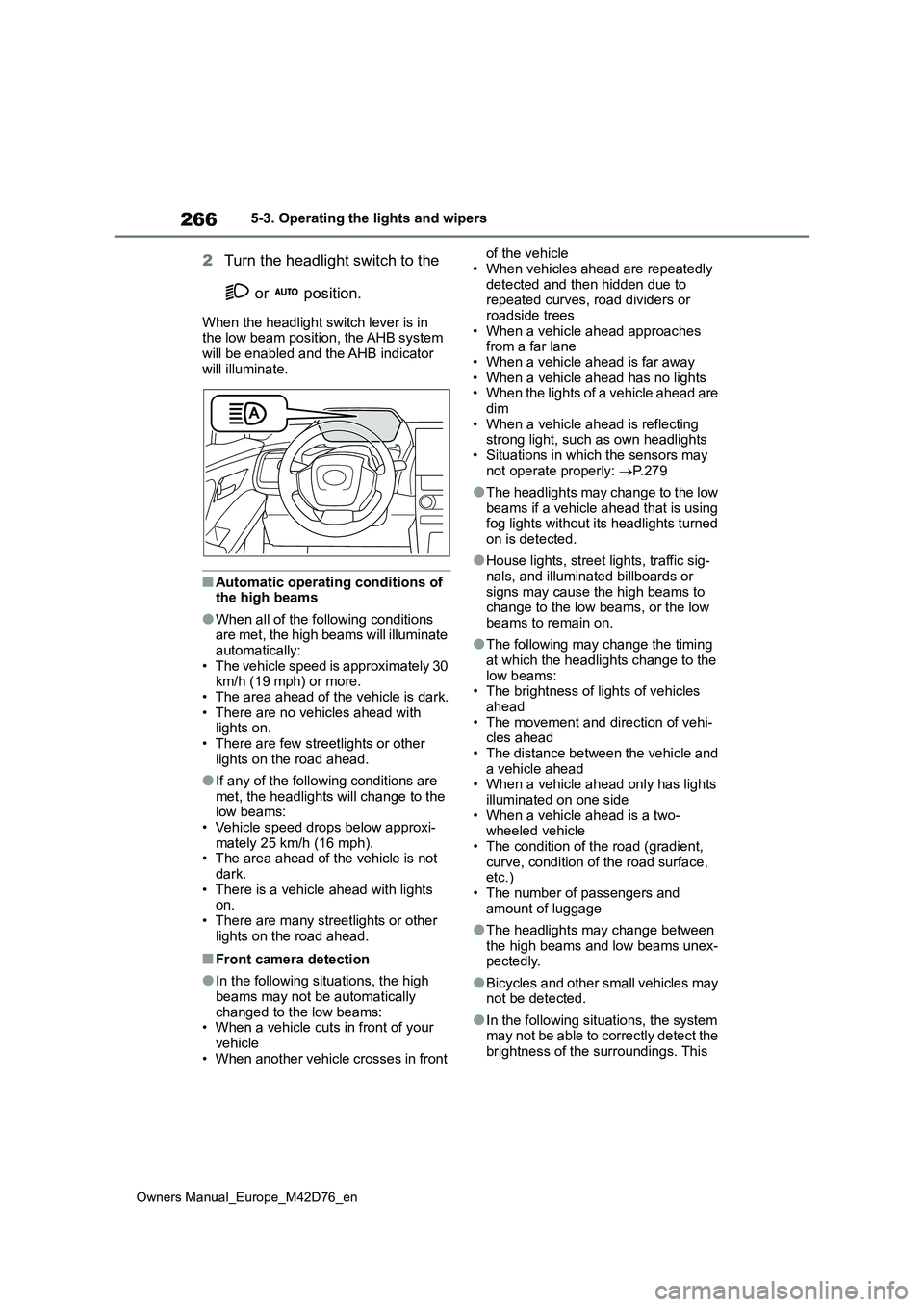
266
Owners Manual_Europe_M42D76_en
5-3. Operating the lights and wipers
2Turn the headlight switch to the
or position.
When the headlight switch lever is in the low beam position, the AHB system
will be enabled and the AHB indicator will illuminate.
■Automatic operating conditions of the high beams
●When all of the following conditions are met, the high beams will illuminate automatically:
• The vehicle speed is approximately 30 km/h (19 mph) or more.• The area ahead of the vehicle is dark.
• There are no vehicles ahead with lights on.• There are few streetlights or other
lights on the road ahead.
●If any of the following conditions are
met, the headlights will change to the low beams:• Vehicle speed drops below approxi-
mately 25 km/h (16 mph). • The area ahead of the vehicle is not dark.
• There is a vehicle ahead with lights on.• There are many streetlights or other
lights on the road ahead.
■Front camera detection
●In the following situations, the high
beams may not be automatically changed to the low beams:• When a vehicle cuts in front of your
vehicle • When another vehicle crosses in front
of the vehicle
• When vehicles ahead are repeatedly detected and then hidden due to repeated curves, road dividers or
roadside trees • When a vehicle ahead approaches from a far lane
• When a vehicle ahead is far away • When a vehicle ahead has no lights• When the lights of a vehicle ahead are
dim • When a vehicle ahead is reflecting strong light, such as own headlights
• Situations in which the sensors may not operate properly: P. 2 7 9
●The headlights may change to the low beams if a vehicle ahead that is using fog lights without its headlights turned
on is detected.
●House lights, street lights, traffic sig-
nals, and illuminated billboards or signs may cause the high beams to change to the low beams, or the low
beams to remain on.
●The following may change the timing
at which the headlights change to the low beams:• The brightness of lights of vehicles
ahead • The movement and direction of vehi-cles ahead
• The distance between the vehicle and a vehicle ahead• When a vehicle ahead only has lights
illuminated on one side • When a vehicle ahead is a two-wheeled vehicle
• The condition of the road (gradient, curve, condition of the road surface, etc.)
• The number of passengers and amount of luggage
●The headlights may change between the high beams and low beams unex-pectedly.
●Bicycles and other small vehicles may not be detected.
●In the following situations, the system may not be able to correctly detect the
brightness of the surroundings. This
Page 282 of 674

280
Owners Manual_Europe_M42D76_en
5-4. Using the driving support systems
radar equipped vehicles, etc., or other
location where strong radio waves or electrical noise may be present
●When a wiper blade is blocking the front camera
●When in a location or near objects which strongly reflect radio waves, such as the following:
• Tunnels • Truss bridges• Gravel roads
• Rutted, snow-covered roads •Walls• Large trucks
• Manhole covers • Guardrail• Metal plates
●When near a step or protrusion
●When a detectable vehicle is narrow, such as a small mobility vehicle
●When a detectable vehicle has a small front or rear end, such as an unloaded truck
●When a detectable vehicle has a low front or rear end, such as a low bed
trailer
●When a detectable vehicle has
extremely high ground clearance
●When a detectable vehicle is carrying
a load which protrudes from its cargo area
●When a detectable vehicle has little
exposed metal, such as a vehicle which is partially covered with cloth, etc.
●When a detectable vehicle is irregu-larly shaped, such as a tractor, side-
car, etc.
●When the distance between the vehi-
cle and a detectable vehicle has become extremely short
●When a detectable vehicle is at an angle
●When snow, mud, etc., is attached to a detectable vehicle
●When driving on the following kinds of roads:• Roads with sharp curves or winding
roads • Roads with changes in grade, such as sudden inclines or declines
• Roads which is sloped to the left or right• Roads with deep ruts
• Roads which are rough and unmain- tained• Roads which frequently undulate or
are bumpy
●When the steering wheel is being
operated frequently or suddenly
●When the vehicle is not in a constant
position within a lane
●When parts related to this system, the
brakes, etc., are cold or extremely hot, wet, etc.
●When the wheels are misaligned
●When driving on slick road surfaces,
such as when it is covered with ice, snow, gravel, etc.
●When the course of the vehicle differs from the shape of a curve
●When the vehicle speed is exces-sively high when entering a curve
●When entering/exiting a parking lot, garage, car elevator, etc.
●When driving in a parking lot
●When driving through an area where
there are obstructions which may con-
Page 283 of 674
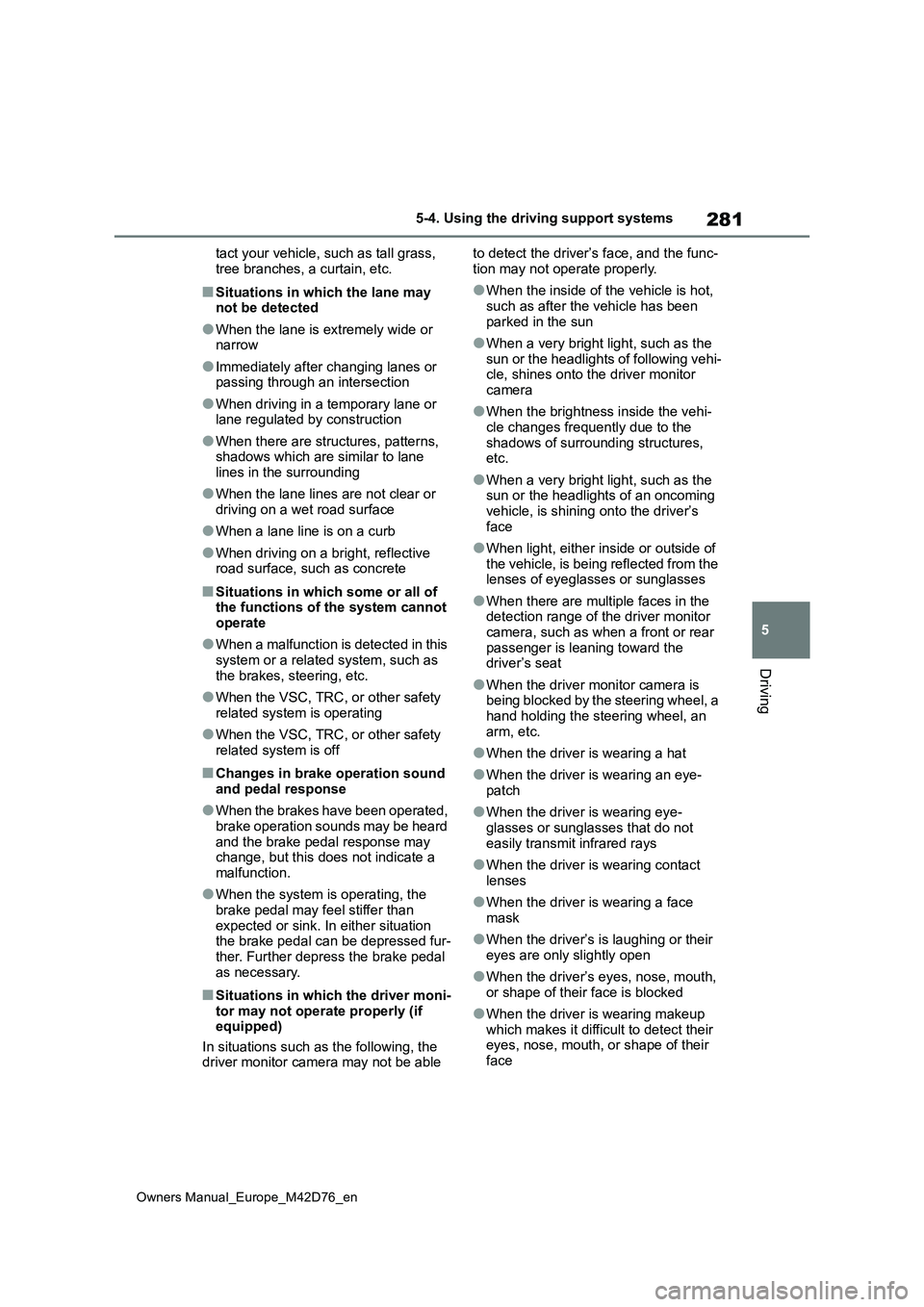
281
5
Owners Manual_Europe_M42D76_en
5-4. Using the driving support systems
Driving
tact your vehicle, such as tall grass,
tree branches, a curtain, etc.
■Situations in which the lane may not be detected
●When the lane is extremely wide or narrow
●Immediately after changing lanes or passing through an intersection
●When driving in a temporary lane or lane regulated by construction
●When there are structures, patterns, shadows which are similar to lane lines in the surrounding
●When the lane lines are not clear or driving on a wet road surface
●When a lane line is on a curb
●When driving on a bright, reflective road surface, such as concrete
■Situations in which some or all of the functions of the system cannot
operate
●When a malfunction is detected in this
system or a related system, such as the brakes, steering, etc.
●When the VSC, TRC, or other safety related system is operating
●When the VSC, TRC, or other safety related system is off
■Changes in brake operation sound and pedal response
●When the brakes have been operated, brake operation sounds may be heard
and the brake pedal response may change, but this does not indicate a malfunction.
●When the system is operating, the brake pedal may feel stiffer than
expected or sink. In either situation the brake pedal can be depressed fur-ther. Further depress the brake pedal
as necessary.
■Situations in which the driver moni- tor may not operate properly (if equipped)
In situations such as the following, the driver monitor camera may not be able
to detect the driver’s face, and the func-
tion may not operate properly.
●When the inside of the vehicle is hot,
such as after the vehicle has been parked in the sun
●When a very bright light, such as the sun or the headlights of following vehi-cle, shines onto the driver monitor
camera
●When the brightness inside the vehi-
cle changes frequently due to the shadows of surrounding structures, etc.
●When a very bright light, such as the sun or the headlights of an oncoming
vehicle, is shining onto the driver’s face
●When light, either inside or outside of the vehicle, is being reflected from the lenses of eyeglasses or sunglasses
●When there are multiple faces in the detection range of the driver monitor
camera, such as when a front or rear passenger is leaning toward the driver’s seat
●When the driver monitor camera is being blocked by the steering wheel, a
hand holding the steering wheel, an arm, etc.
●When the driver is wearing a hat
●When the driver is wearing an eye-
patch
●When the driver is wearing eye-
glasses or sunglasses that do not easily transmit infrared rays
●When the driver is wearing contact lenses
●When the driver is wearing a face mask
●When the driver’s is laughing or their eyes are only slightly open
●When the driver’s eyes, nose, mouth, or shape of their face is blocked
●When the driver is wearing makeup which makes it difficult to detect their eyes, nose, mouth, or shape of their
face